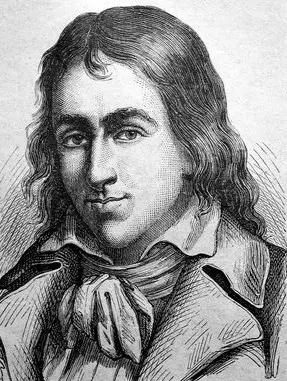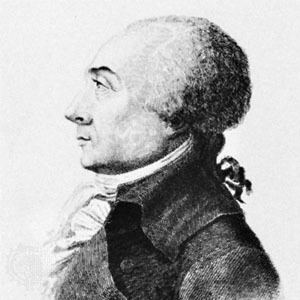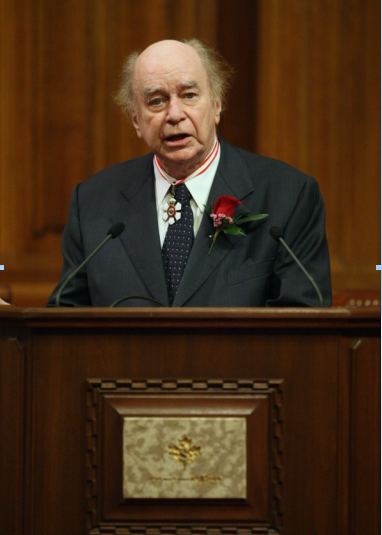Resigned March 23, 1794 Role Journalist | Name Jacques Hebert | |
 | ||
Full Name Jacques Rene Hebert Born November 15, 1757Alencon, France ( 1757-11-15 ) Children Scipion-Virginia Hebert (1793-1830) Parents Jacques Hebert (?-1766) and Marguerite La Beunaiche de Houdre (1727-1787) Occupation Journalist, writer, publisher, politician Spouse Marie Marguerite Francoise Hebert (m. 1792–1794) Similar People Camille Desmoulins, Georges Danton, Pierre Gaspard Chaumette, Louis Antoine de Saint‑Just, Jacques Pierre Brissot | ||
Former senator jacques hebert dies at 84
Jacques René Hébert ([ebɛʁ]; 15 November 1757 – 24 March 1794) was a French journalist, and the founder and editor of the extreme radical newspaper Le Père Duchesne during the French Revolution. His followers are usually referred to as the Hébertists or the Hébertistes; he himself is sometimes called Père Duchesne, after his newspaper.
Contents
- Former senator jacques hebert dies at 84
- Early life
- Pre Duchesne
- Revolutionary role
- Reign of Terror
- Dechristianization
- Clash with Robespierre arrest conviction and execution
- Influence
- Jacques h bert quitte sarbakan
- References

Early life

He was born on 15 November 1757 at Alençon, to goldsmith, former trial judge, and deputy consul Jacques Hébert (died 1766) and Marguerite Beunaiche de Houdrie (1727–1787). Jacques-René Hébert studied law at the College of Alençon and went into practice as a clerk in a solicitor of Alençon, at which time he was ruined by a lawsuit against a Dr. Clouet. Hébert fled first to Rouen and then to Paris. For a while he passed through a difficult financial time and lived through the support of a hairdresser in rue des Noyers. There he found work in a theater, la République, where he wrote plays in his spare time, but these were never produced. He was fired for stealing. He then entered the service of a doctor. It is said he lived through expediency and scams.

In 1789, he began his writing with a pamphlet "la Lanterne magique ou le Fléau des Aristocrates" (Magic Lantern, or Scourge of Aristocrats). He published a few booklets. In 1790, he attracted attention through a pamphlet he published, and became a prominent member of the club of the Cordeliers in 1791.
Père Duchesne

From 1790 until his death in 1794 Hébert became a voice for the working class of Paris through his highly successful and influential journal, Le Père Duchesne. In his journal, Hébert assumed the voice of a patriotic sans-culotte named Père Duchesne and would write first-person narratives in which Père Duchesne would often relay fictitious conversations that he had with the French monarchs or government officials. These stories encouraged violent behaviors and utilized foul language, however, Père Duchesne's stories were also witty, reflective, and resonated deeply with Parisian workers. Street hawkers would yell: Il est bougrement en colère aujourd’hui le père Duchesne! (Father Duchesne is very angry today!).

Although Hébert did not create the image of the Père Duchesne, his use of the character helped to transform the symbolic image of Père Duchesne from that of a comical stove-merchant into a patriotic role model for the sans culottes In part, Hébert's use of Père Duchesne as a revolutionary symbol can be seen by his appearance as a bristly old man who was portrayed as smoking a pipe and wearing a Phrygian cap. Because he reflected both the speech and dressing style of his audience, his readers listened to and followed his message. The French linguist and historian Ferdinand Brunot called Hébert "The Homer of filth" because of his ability to use common language to appeal to general audiences In addition, Père Duchesne's appearance played into the tensions of the revolution through the sharp contrast of his clothing and portrayal as a laborer against the crown and aristocracy's formal attire.
Hébert was not the only writer during the French Revolution to use the image of Père Duchesne nor was he the only author in the period to adopt foul language as a way of appealing to the working class. Another writer at the time, Lemaire, also wrote a newspaper entitled Père Duchêne (although he spelt it differently than Hébert ) from September of 1790 until May 1792 in which he assumed the voice of a "moderate patriot" who wanted to conserve the relationship between the king and the nation. Lemaire's character also used a slew of profanities and would address France's military. Hébert's paper, however, became far more popular. In part, this was due to the Paris Commune deciding to buy his papers and distribute them to the French military for distribution to soldiers in training. For example, starting in 1792 the Paris Commune and the ministers of war Jean-Nicolas Pache and, later, Jean Baptiste Noël Bouchotte bought several thousand copies of Le Père Duchesne which were distributed free to the public and troops. This happened again in May and June of 1793 when the Minister of War bought copies of newspapers in order to "enlighten and animate their patriotism." It is estimated that Hébert received 205,000 livres from this purchase.
Hébert's political commentary between 1790 and 1793 focused on the lavish excesses of the monarchy. Initially, from 1790 and into 1792, Le Père Duchesne supported a constitutional monarchy and was even favorable towards King Louis XVI and the opinions of the Marquis de La Fayette. His violent attacks of the period were aimed at Jean-Sifrein Maury, a great defender of papal authority and the main opponent of the Civil Constitution of the Clergy. Although the character of Père Duchesne supported a constitutional monarchy, he was always highly critical of Marie Antoinette. Knowing that the queen was an easy target for ridicule after the Diamond Necklace Affair, she became a consistent target in the paper as a scapegoat for many of France's political problems. By identifying Marie Antoinette's lavish excesses and alleged sexuality as the core of the monarchy's problems, Hébert's articles suggested that, if Marie Antoinette would change her ways and renounce aristocratic excesses, then the monarchy could be saved and the queen could return to the good will of the people. Despite his view that the monarchy could be restored, Hébert was skeptical of the queen's willingness to do so and often characterized her as an evil enemy of the people by referring to Marie Antoinette as "Madame Veto" and even addressing Louis XVI as "drunken and lazy; a cuckolded pig". Initially, Hébert was trying to not only educate his readers about the queen, but also awaken her to how she was viewed by the French public. Many of the conversations that Père Duchesne carries with her in the newspaper are attempts at either showcasing her supposed nymphomania or attempts to beg her to repent and reverse her wicked ways.With the king's failed flight to Varennes his tone significantly hardened.
Revolutionary role
On 17 July 1791, Hébert was at the Champ de Mars to sign a petition to demand the removal of King Louis XVI and was caught up in the subsequent Champ de Mars massacre by troops under Lafayette. This put him in the revolutionary mindset, and the Le Père Duchesne adopted a sloppier style to better appeal to the masses. Le Père Duchesne began to attack Lafayette, Mirabeau, and Bailly. Following Louis's failed flight to Varennes he began to attack both Louis and Pope Pius VI as well.
Hébert met his future wife Marie Goupil (born 1756), a 37-year-old former nun who had left convent life at the Sisters of Providence convent at rue Saint-Honoré. Marie's passport from this time shows regular use. They married on 7 February 1792, and had a daughter, Virginia Scipion-Hébert (7 February 1793 - 13 July 1830). During this time, Hébert had a luxurious, bourgeois life. He entertained Jean-Nicolas Pache, the mayor of Paris and Minister of War, for weeks, as well as other influential men, and liked to dress elegantly and surround himself with beautiful objects as beautiful tapestries—an attitude that can be contrasted to that of Pierre Gaspard Chaumette. Where he got the financial resources to support his lifestyle is unclear; however, there are Jean-Nicolas Pache's commissions to print thousands of issues of Le Père Duchesne and his relationship to Delaunay d'Angers, mistress and wife of Andres Maria de Guzman.
As a member of Cordeliers club, he had a seat in the revolutionary Paris Commune where on the 9th and 10th of August, 1792 he was sent to the Bonne-Nouvelle section of Paris. As a public journalist, he supported the September Massacres. On 22 December 1792, he was appointed the second substitute of the procureur of the commune, and through to August 1793 supported the attacks against the Girondin faction. In April–May 1793 he, along with Marat and others, violently attacked Girondins.
In February 1793, he voted with fellow bourgeois Hébertists against the Maximum Price Act, a Price ceiling on grain, on the grounds it would cause hoarding and stir resentment. On 20 May 1793 the moderate majority of the National Convention formed the Special Commission of Twelve, which was designed to investigate and prosecute conspirators. At the urging of the Twelve on 24 May 1793 he was arrested.
However, Hébert had been warned in time, and, with the support of the Sans Culottes, the National Convention was forced to order his release three days later.
Reign of Terror
Between May 31-June 2, 1793, Paris sections — encouraged by the enragés ("enraged ones") Jacques Roux and Jacques Hébert — protested outside the Convention, calling for administrative and political purges, a low fixed price for bread, and a limitation of the electoral franchise to sans-culottes alone. With the backing of the National Guard, they convinced the Convention to arrest 31 Girondin leaders, including Jacques Pierre Brissot. Following these arrests, the Jacobins gained control of the Committee of Public Safety on 10 June, installing the revolutionary dictatorship. On 13 July the assassination of Jean-Paul Marat — a Jacobin leader and journalist known for his aggressive rhetoric — by Charlotte Corday, a Girondin, resulted in further increase of Jacobin political influence. Georges Danton, the leader of August 1792 uprising against the King, was removed from the Committee. On 27 July, Maximillien Robespierre, known as "the Incorruptible", made his entrance, and quickly became the most influential member of the Committee as it moved to take radical measures against the Revolution's domestic and foreign enemies.
Meanwhile, on 24 June, the Convention adopted the first republican constitution of France, the French Constitution of 1793. It was ratified by public referendum, but never put into force; like other laws, it was indefinitely suspended by the decree of October that the government of France would be "revolutionary until the peace". The eventual constitution under the Directory was quite different.
Facing local revolts, foreign invasions and riots in both the East and West of the country, the most urgent government business was the war. On 17 August, the Convention voted for general conscription, the levée en masse, which mobilized all citizens to serve as soldiers or suppliers in the war effort. On 5 September the Convention institutionalized The Reign of Terror: systematic and lethal repression of perceived enemies within the country.
The result was policy through which the state used violent repression to crush resistance to the government. The guillotine became the symbol of a string of executions: Louis XVI had already been guillotined before the start of the terror; Marie-Antoinette, the Girondins, Philippe Égalité, Madame Roland and many others lost their lives under its blade. The Revolutionary Tribunal summarily condemned thousands of people to death by the guillotine, while mobs beat other victims to death. Sometimes people died for their political opinions or actions, but many for little reason beyond mere suspicion, or because some others had a stake in getting rid of them. Most of the victims received an unceremonious trip to the guillotine in an open wooden cart (the tumbrel). Loaded onto these carts, the victims would proceed through throngs of jeering men and women.
The victims of the Reign of Terror totaled approximately 50,000. Among people who were condemned by the revolutionary tribunals, about 8 percent were aristocrats, 6 percent clergy, 4 percent middle class, and 72 percent were workers or peasants accused of hoarding, evading the draft, desertion, rebellion, and other purported minimal crimes. Of these social groupings, the clergy of the Roman Catholic Church suffered proportionately the greatest loss.
Dechristianization
Dechristianization was a movement that took hold during the French Revolution in which advocates believed that, in order to pursue a secular society, they had to reject the superstitions of the old regime and, as an extension, Catholicism. The trend toward secularization hard already begun to take hold throughout France during the eighteenth century; however, between September 1793 and August 1794, French politicians began discussing and embracing notions of "radical dechristianization." While Robespierre advocated for the right to religion and believed that aggressively pursuing dechristianization would spur widespread revolts throughout rural France, Hébert and his followers, the Hébertists, wanted to spontaneously and violently overhaul religion. The program of dechristianization waged against Catholicism, and eventually against all forms of Christianity, included the deportation of clergy and the condemnation of many of them to death, the closing of churches, the institution of revolutionary and civic cults, the large scale destruction of religious monuments, the outlawing of public and private worship and religious education, forced marriages of the clergy and forced abjurement of their priesthood. On 21 October 1793 a law was passed which made all suspected priests and all persons who harbored them liable to death on sight.
On November 10, 1793, dechristianization reached what many historians consider the climax of the movement when the Hébertists moved the first celebration of the Festival of Reason, a civic festival celebrating the goddess of Reason, from the Circus of the Palais Royale to the Cathedral of Notre Dame and reclaimed the cathedral as a "Temple of Reason." On 7 June Robespierre, who had previously condemned the Cult of Reason, advocated a new state religion and recommended that the Convention acknowledge the existence of God. On the next day, the worship of the deistic Supreme Being was inaugurated as an official aspect of the Revolution. Compared with Hébert's somewhat popular festivals, this austere new religion of Virtue was received with signs of hostility by the Parisian public.
Clash with Robespierre, arrest, conviction, and execution
After successfully attacking the Girondins, he continued to attack others whom he viewed as too moderate including Danton, Philippeau, and Robespierre in the fall of 1793.
The government, with support from the Jacobins, was exasperated and finally decided to strike on the night of 13 March 1794, despite the reluctance of Barère de Vieuzac, Collot d'Herbois and Billaud-Varenne. The order was to arrest the leaders of the Hébertists, these included individuals in the War Ministry and others.
In the Revolutionary Tribunal, Hébert was treated very differently from Danton, more like a thief than a conspirator; his earlier scams were brought to light and criticized. He was sentenced to death with his co-defendants on the third day of deliberations. Their execution by guillotine took place on 24 March 1794. Hébert fainted several times on the way to the guillotine, and screamed hysterically when he was placed under the blade. Hébert's executioners amused the crowd by adjusting the guillotine so that its blade stopped inches above his neck. Only on the fourth attempt was the execution carried out. His corpse was disposed of in the Madeleine Cemetery. His widow was executed twenty days later on 13 April 1794. Her corpse was disposed of in the Errancis Cemetery.
Influence
It is difficult to ascertain the extent to which Hébert's publication Le Père Duchesne impacted the outcomes of political events between 1790 and 1794. French revolutionary historians such as Jean-Paul Bertraud, Jeremy D. Popkin, and William J. Murray each investigated French Revolutionary press history and determined that while the newspapers and magazines that one read during the revolution may have influenced their political leanings, it did not necessarily create their political leanings. One's class, for example, could be a significant determinant in directing and influencing one's political decisions. Therefore, Hébert's writings certainly influenced his audience to some extent, but that does not mean that it changed the political outcomes of the French Revolution. That being said, his wide readership and voice throughout the Revolution means that he was a significant public figure and Le Père Duchesne's ability to influence the general population of France was indeed notable.
